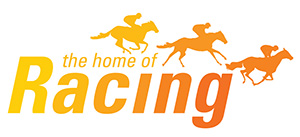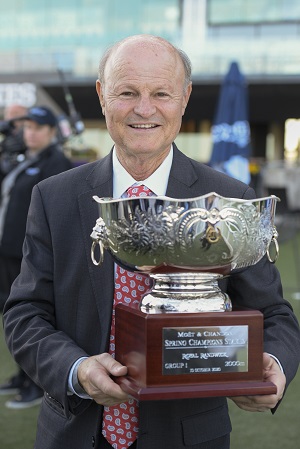

Inglis proudly bring you:
David Payne – What A Remarkable Career
By John Curtis
DAVID Payne wanted no part of it and bailed out only a month after entering the Jockey Academy in South Africa.
Coerced to return when the chief steward told his father he thought “the young fella could make it”, so began a remarkable career in both his native country and his adopted Australia after making the move to Sydney two decades ago.
Payne had never seen a horse until he and his siblings peered through the picket fence at Greyville racecourse (the biggest in Natal) walking to and from school, and became fascinated.

Trainer David Payne. Photo: Bradley Photos
“I was one of 10 children and our family had little money, and the racing looked very exciting,” Payne said.
“Having told Dad I wanted to be a jockey, I was signed up to the Jockey Academy, which was then at Mariannhill near Pinetown (in the hills adjoining Durban).
“But I ran away after a month. It was like boarding school and I hated it.”
Payne doesn’t know which direction his life would have taken had he not returned to the Academy.
“Who knows,” he said. “I might have been a plumber or perhaps a copper.”
Thankfully for the racing industry, he became neither.
Payne rode 399 winners, and was twice both champion apprentice and champion jockey.
The best horses he rode were Naval Escort and Double Eagle, and he delighted in winning a couple of “match races” at different provinces.
When increasing weight led to his temporary retirement from the saddle at 24 years of age, he was encouraged to take up training.
But it never got off the ground. Well, not at first!
“People promised me horses if I gave up riding and I did, but nothing came forward,” Payne revealed.
“So I went back to what I knew, and was doing some riding for an owner called Norman Ferguson, whose trainer sadly was dying of cancer.
“A couple of months later, I was training his horses and started with a stable of eight.”
Despite the initial blip to his training career, the delay proved to be a blessing in disguise.
“I threw my leg over a young horse to ride him work and said: ‘Wow, this horse could be something pretty good’.”
He turned out more than “pretty good”. Racing as In Full Flight, he won 16 of his 19 starts and his trainer remains adamant he would have proved himself on the world stage had he not died prematurely as a four-year-old.
“In Full Flight was an absolute freak; six of his wins were at Group 1 level,” Payne said.
“He could win at weight-for-age from 1000m to 2000m.
“We were setting him for the Arc De Triomphe at Longchamps, but he burst a lung during trackwork one morning and died.
“In Full Flight was undoubtedly the best horse I have been associated with.”
Huge praise indeed when you consider Payne trained more than 100 Group 1 winners in South Africa (including every major, some up to five times) and his current Australian tally is 10.
Payne chuckles when he says In Full Flight was by a stallion called New South Wales, now his home State.
He achieved a rare feat, riding (Chimboraa) and training (In Full Flight as a three-year-old beat older horses) the winner of South Africa’s renowned Durban July Handicap at Greyville.
Having spent 30 years training in the “Rainbow Nation”, Payne in 2002 decided to pack up and move to Australia.
“South Africa had become too political and violent,” he said. “From a family viewpoint, it was the right move and we have never regretted it.”
Still, getting here wasn’t so easy, and neither was the start to his training venture in a new country, obviously having to kick off from scratch.
“I was 54 and they said I was too old when I applied to emigrate,” Payne explained. “But because of my record, I was fortunate to get one of 14 special visas.
“Sydney was the choice because I had often stopped here for a week en route from the yearling sales in New Zealand to visit friends who had already moved here, and they said I should do the same with my family.
“My wife Merle and daughter Tracy came initially and son Gary got here three years later. We now have two lovely Aussie grandsons.
“I started out at Randwick, but took about six months to get going. It was a real struggle.”
Payne almost had a winner at headquarters with his first Australian starter, Kiwi filly Sierra Dane, who was unluckily and narrowly beaten, ironically by another daughter of Danehill (Max Lees’ Fiammarosa) in a 1400m 3YO Maiden on August 21, 2002.
After another second at Listed level and sixth in the Group 1 Flight Stakes, she gave Payne an Aussie breakthrough at Randwick on Melbourne Cup day that year.
A chance meeting – courtesy of fellow South African expat, bloodstock agent James Bester – with businessman John Camilleri (later to gain worldwide notoriety as Winx’s breeder) turned around Payne’s fortunes.
“James had bought this Zabeel filly for John, and he was intending to send her to a Melbourne trainer,” he said.
“He recommended me, but John didn’t know who I was. James set up a meeting and over a cuppa, John agreed to allow me to train the filly.”
That was Unearthly, whose 2003 Flight Stakes triumph was the first of Payne’s 10 Australian Group 1 triumphs; the others being Master Of Design (2012 TJ Smith Stakes), Criterion (2014 Rosehill Guineas and Australian Derby), Ace High (2017 Spring Champion Stakes and Victoria Derby), and his current stable flag-bearer Montefilia (2020 Flight Stakes and Spring Champion Stakes, 2021 The Metropolitan and the recent Ranvet Stakes at Rosehill Gardens).
After four years at Randwick, Pope Benedict XVI’s visit to Sydney in 2008 for World Youth Day (celebrated at Randwick racecourse) triggered a transfer to Rosehill.
“Randwick trainers had to move, and I could have gone to Warwick Farm where stables were built, but it was too far from home at Mosman,” Payne said.
“John Camilleri subsequently introduced me to his cousin John Cordina, and we have enjoyed great success with horses such as Ace High, Centennial Park, Gallant Tess, Rock Hero, etc.”
Whilst Payne rates highly his 2012 TJ Smith win with an unsound Master Of Design at $31 for Australian Bloodstock after he had previously raced for prominent trainers in Melbourne and Perth, he says he can’t go past Montefilia’s recent Ranvet Stakes toppling of Melbourne Cup winner Verry Elleegant as the pick of his local Group 1 achievements.
“We were quietly confident at only her second run back, and to actually win the Ranvet beating such an outstanding mare was very special.”
With Jason Collett’s subsequent injury, Hugh Bowman (with 102 Group 1s to his credit) goes back on Montefilia in Saturday’s $4m Queen Elizabeth Stakes (2000m) on the second day of The Championships.
“It won’t be an easy race, but our mare is in great shape and I’m sure she will be very competitive again,” Payne said.
“Then she will go for another break, and the Melbourne Cup (3200m) at Flemington in November is our long-range goal.
“She could have run in it last year after winning The Metropolitan and then finishing fourth in the Caulfield Cup, but I didn’t consider she was strong enough for the 3200m and her owners were on side with my decision.”
Payne bought the daughter of 2015 Doncaster Mile winner Kermadec for $130,000 as a yearling, attracted by her being a good walking filly and very athletic.
“I told the owners she could run a place when she won the Beaumont Handicap (1400m) on Newcastle Newmarket day two years ago at $51 at her first start, and knew we had something not bad when she ran fourth in the Group 3 Baillieu (1400m) at Rosehill next run,” he said.
A thorough gentleman and highly respected in the industry, Payne has prepared nearly 600 winners in his 20 seasons in Australia.
Now 74 and having scaled back his stable numbers in recent years to focus mainly on metropolitan racing, he continues to ply his trade, chasing further success at racing’s highest level.
Unlike the beginning of his stint all those years ago at the Jockey Academy, he has no intention of quitting.
“You have to keep active, and I enjoy what I’m doing,” he said. “I reckon I’ll keep going until they put me in a wooden overcoat.”






